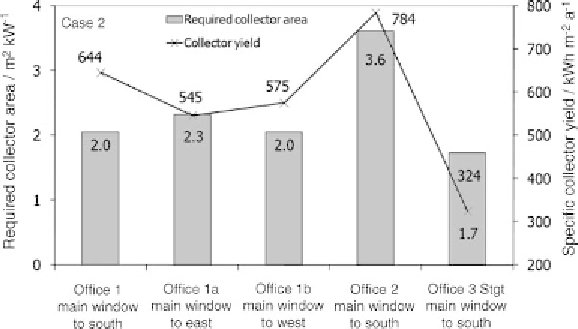Environmental Engineering Reference
In-Depth Information
Figure 6.18
Correlation between required collector area and maximum building cooling load
to Case 2 conditions, namely a wet cooling tower, a low cold distribution temperature
network of 6
◦
C/12
◦
C and variable generator inlet temperatures. The solar fraction
was always at 80%. The office building with low internal loads and the main windows
facing south requires 2m
2
kW
−
1
of solar thermal collector surface area (office 1). The
same building with a different orientation to the east can be about 20% bigger in size to
fit the 15 kWmaximum cooling power. It has a 15% higher collector surface area and
15% less collector yield. If the building is orientated with the main window front to the
west, the building surface area is only slightly higher than the south-orientated building
with a lower total cooling energy demand. The collector surface area is the same as for
a south-orientated building, which at lower operating hours means higher total costs.
The same building now dominated by internal loads (office 2) needs a collector sur-
face area of 3.6m
2
kW
−
1
, which is 80% higher than for office 1, although the required
maximum power is still only 15 kW. Due to the longer operating hours of the solar
thermal cooling system, the specific collector yield is 22% higher at 784 kWhm
−
2
a
−
1
at the location in Madrid, so that the solar thermal efficiency is 45% for solar cooling
operation alone. If the office building with low internal loads is located in Stuttgart
with its more moderate climate, the collector yield drops to 324 kWhm
−
2
a
−
1
and the
required surface area is 1.7m
2
kW
−
1
(see Figure 6.18).
For the location in Madrid, the collector surface area required to cover 1MWh
of cooling energy demand varies between 1.6 and 3.5m
2
MWh
−
1
, the depending on
the building orientation and control strategy chosen. The lower the cooling energy
demand, the higher the required surface area per megawatt hour. This is very clear for
the building in Stuttgart with its low total energy demand of 4.7MWh, where between
4.6 and 6.2m
2
of solar thermal collector surface area per megawatt hour is necessary
to cover the energy demand (see Figure 6.19). The ratios between collector surface and
cooling energy demand vary by about 25% for the same location and control strategy.

Search WWH ::

Custom Search